Art Is the Lie That Makes Us Realize the Truth
Art: The Lie that Tells the Truth
I was talking with a colleague the other day about movies and they told me well-nigh one that was, "based on a truthful story." I replied, "That's besides bad." Whenever I see that phrase, I wonder, Why weren't they creative plenty to embellish the truth to brand a more interesting story? What makes a bad story that is true better than a good story that is false?
When I was little, I read a lot. Ane of the stories that I found particularly haunting Blood brother's Grimm, The Wolf and the Seven Little Goats. Basically information technology was this: Female parent goat goes away for the day. The seven little goats are at dwelling. The wolf appears with a vocalization softened by honey and a paw dipped in flour. The trivial goats retrieve it is the mother and allow the wolf in. They are gulped down, all but the littlest who hides in a grandfather clock. The mother caprine animal returns dwelling to find the wolf sleeping. She takes a big pair of pair of scissors and snips open the sleeping wolf's stomach and rescues her children. And so she fills the wolf with stones, sews him up and dumps him in the river.
I found the story engrossing and I read it over and over. I was mostly impressed with the style the wolf used simple materials to alter its advent in a way that was convincing plenty for the goats.
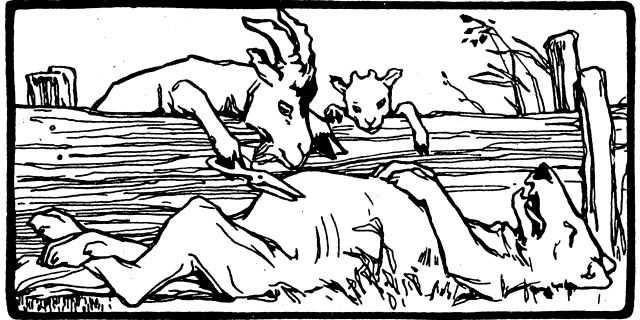
I'm leading into a famous quote.
Pablo Picasso stated in a alphabetic character of 1923 to Marius de Zayas, "We all know that Art is not truth. Art is a lie that makes us realize truth."
In exploring this statement, I will heighten a number of questions for which I may not provide answers. I will discuss lying in fine art, and I will have to likewise discuss truth in art. I will also draw upon the works of numerous artists to demonstrate possibilities as artists have recognized the questions that I will bear upon upon.
Take a look at works done by Picasso in 1923. They're easy to find on line. He painted portraits and a number of seated harlequins. The paintings are certainly well done but nosotros may non fully yet meet in them what he means by his quote.
Showtime, before we can explore his pregnant, nosotros need to see if we tin work toward a definition so that we are speaking the aforementioned language.
What is a lie? More often than not people consider a prevarication to be a faux statement with the intention of deceiving someone else. If you ask me what I'grand doing correct now and I say that I'thousand swimming to France, y'all will most likely advise I am telling a lie, peculiarly if yous know I'm sitting at the computer typing and that I am currently nowhere near France.
In accepting a definition such equally this, we mostly have it that the person stating the lie knows the argument is simulated. So I am not talking about repeating a fact nosotros accept to be true, that is later plant out to be a lie. Purposely misrepresenting some fact is I would argue the most common sense and usage of the discussion prevarication.
When we are not aware of the prevarication, or when we brand a mistake and inadvertently lie, we tin obtain humor as in the moving picture Monty Python and the Holy Grail 1975. To cross the bridge of death one must respond three questions truthfully.
Bridgekeeper: Stop. Who would cross the Span of Expiry must respond me these questions iii, ere the other side he see.
Sir Lancelot: Ask me the questions, bridgekeeper. I am non afraid.
Bridgekeeper: What… is your name?
Sir Lancelot: My name is Sir Lancelot of Camelot.
Bridgekeeper: What… is your quest?
Sir Lancelot: To seek the Holy Grail.
Bridgekeeper: What… is your favourite colour?
Sir Lancelot: Blue.
Bridgekeeper: Go on. Off you go.
Sir Lancelot: Oh, thank you. Thanks very much.
Bridgekeeper: Stop. What… is your proper noun?
Galahad: Sir Galahad of Camelot.
Bridgekeeper: What… is your quest?
Galahad: I seek the Grail.
Bridgekeeper: What… is your favourite colour?
Galahad: Bluish. No, yel…
[he is likewise thrown over the edge]
This is funny because nosotros generally believe that a lie is purposefully deceiving someone, we, the liars, know nosotros deceive.
Picasso likewise added, fine art tin brand u.s. realize truth. What sort of truth tin art make the states realize? And so we must over again intermission. What is truth? Here, nosotros have a long history of philosophical inquiry.
In an extremely simple reduction, philosophers M.E. Moore and Bertrand Russell, truth is correspondence with a fact. Thus, G.E. Moore when asked to evidence the existence of the external earth, could say, hither is ane mitt, here is another hand. That is the truth, the proof, of the external earth.
That darn one-time lying art and information technology's problematics.
We might start with a life size, extremely realistic sculpture by Duane Hanson is truth, because it corresponds with facts of the world, namely that the sculpture at first glance looks very much similar a person. There are many stories of people going upward to one of his sculptures to ask a question.
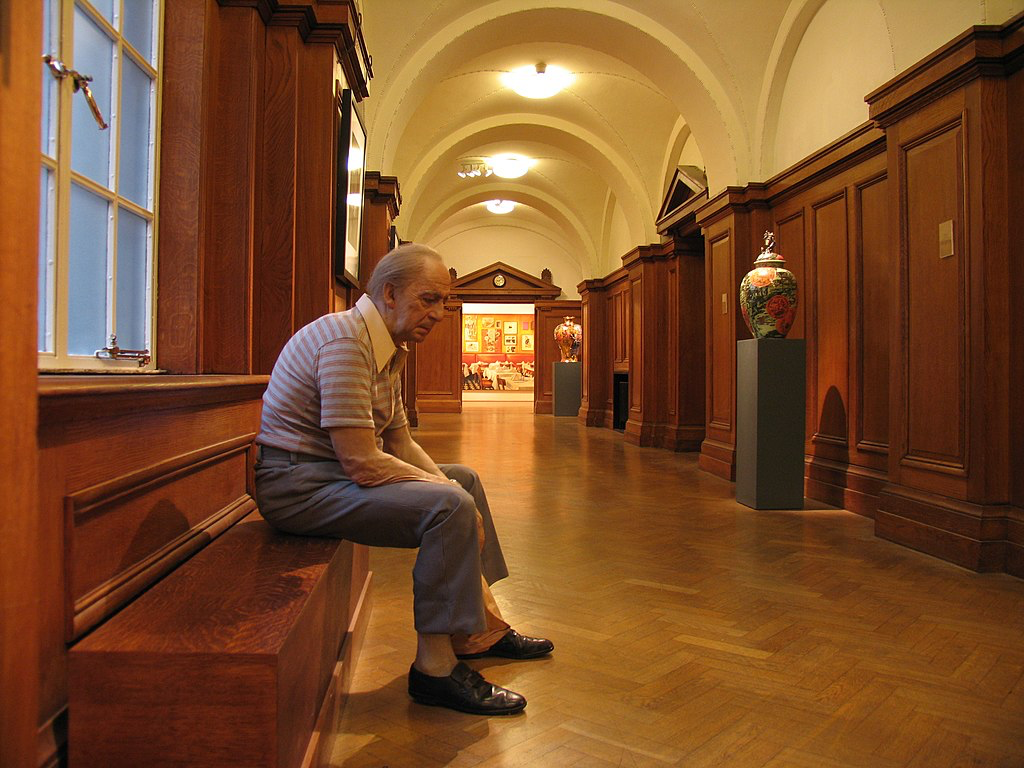
The group Improv Everywhere institute an actor who looked like the painting of Male monarch Philip the Fourth of Espana, in the Metropolitan Museum of Art, a 400 yr former work of fine art painted by Velazquez. The actor then stood near the painting and signed autographs. People including ane guard asked if he was the real person in the painting, not even so understanding the painting was so one-time. Finally a guard came and demanded they exit, which they did. No need to get arrested for lying to make fine art.
Superficially, we tin can say this work of art represents, or depicts in a realistic way, in this case a once living person of the real world.
Pliny the Elder in his volume Naturalis Historia described a contest between Parrhasius and Zeuxis. Nosotros don't have their paintings today merely we tin run across go the idea from the work of others. Zeuxis painted grapes so realistically a bird flew down to eat them merely only pecked at the sheet. They then went to Parrhasius' studio and Zeuxis asked him to pull the curtain back to show him his own work. But the curtain was painted on. Parrhasius considered himself the winner considering in the first case the painter had fooled the bird. In the second instance the painter had fooled another painter.
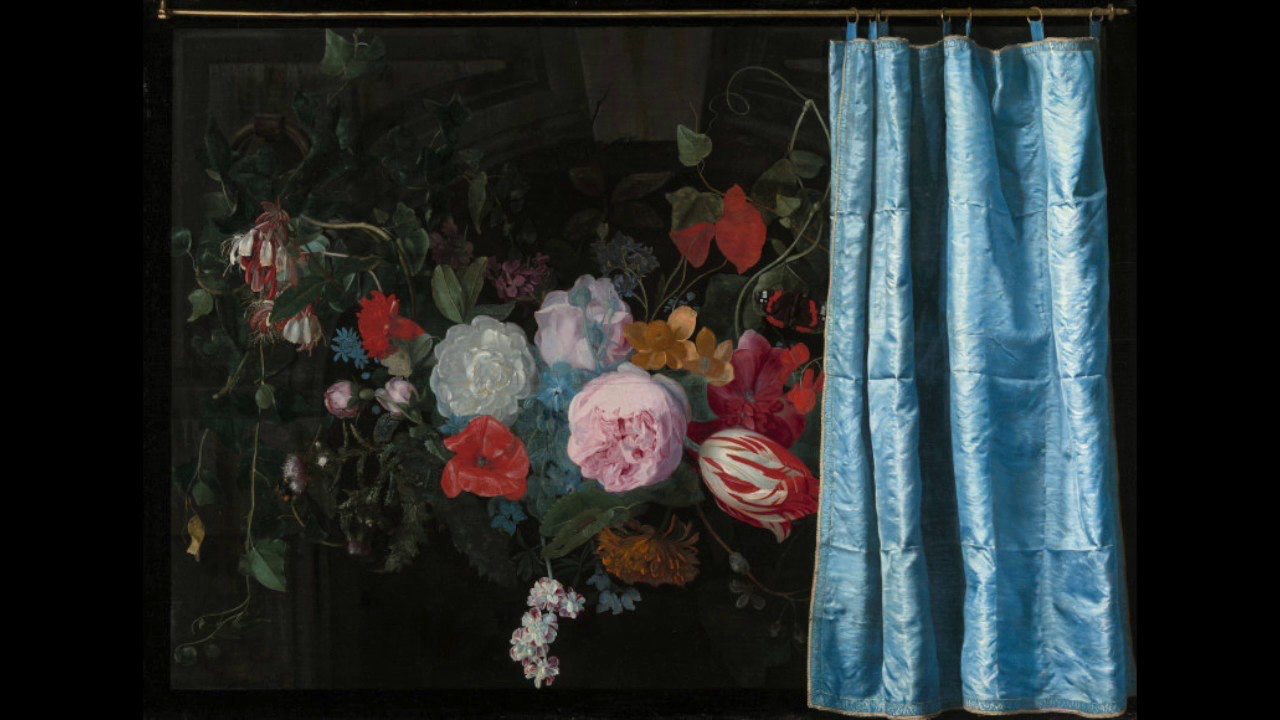
Just what if we do not recognize the reality that the piece of work of art is supposed to stand for to?
Let's call up of a Modernist painting by Barnett Newman titled Who'southward Agape of Cerise, Yellow and Blue that consists of planes and lines of color.
What exactly is the fact that the art corresponds with? Certainly it is a fact that in oil pigment pigment is basis with linseed oil into paint? Is this truth? Is the truth found in the paint is put upon a surface of the canvas? Here equally in a brush stroke. Is some sort of reality and truth.
If we begin to concur with the to a higher place, that truth is found in the paint and the mark, is this painting a collection of facts? Would we walk into the museum and say, "Come expect, this painting past Newman is phenomenal for its truth, which is too so amazingly moving, because I run into clear evidence of the pigment footing with oil and applied with marks. Wow!" On the contrary, information technology was attacked with a knife.
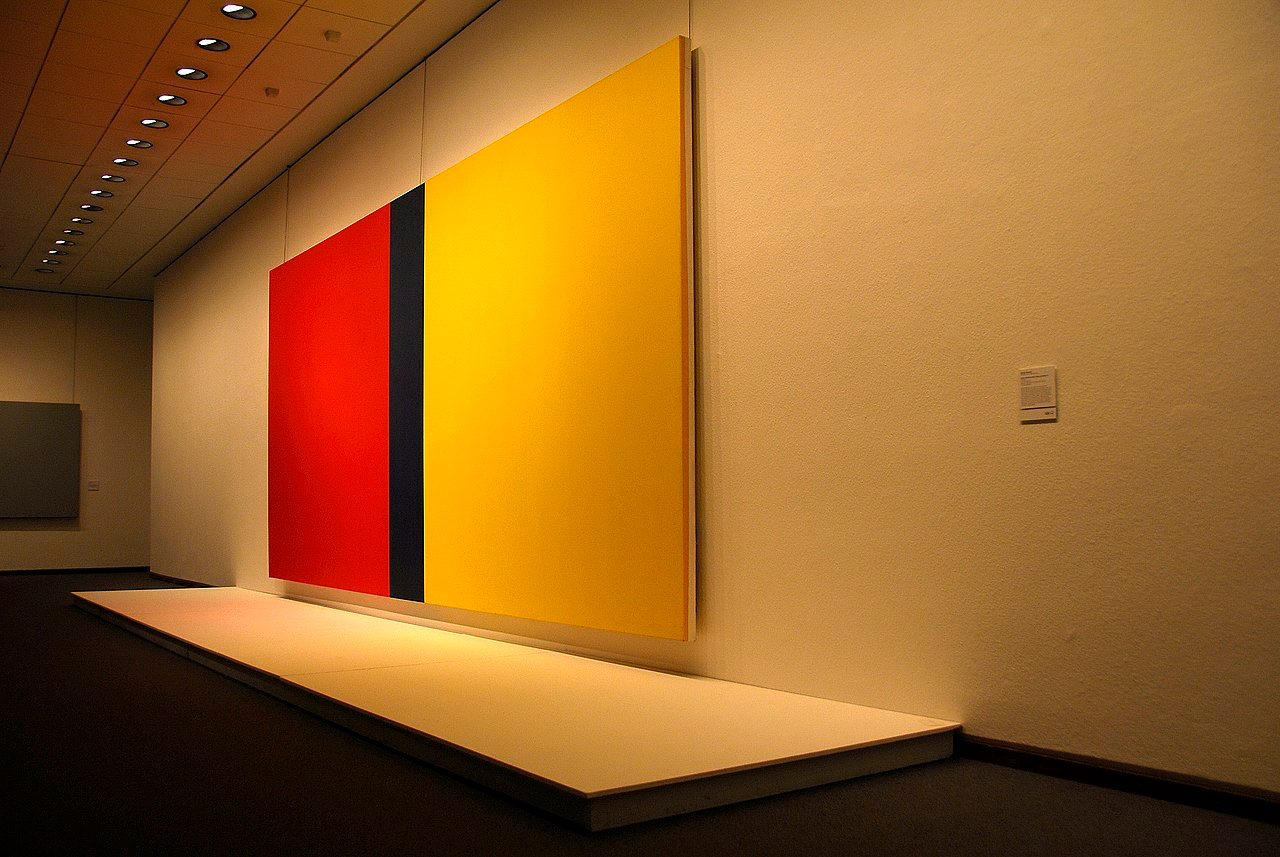
Eugene Delacroix recognized this tension between material and truth. He once said, "I tin can pigment you lot the peel of Venus with mud, provided you let me environment it as I will." He understood that something of a fact was embodied in the pieces of colored mud, for lack of a better word I suppose some people telephone call it paint. The fashion the marks came together could build to something, in this instance Venus, the goddess who represented love, beauty, and seduction.
In arguing for the marks of a pigment'southward application I think of Harold Osborn, writer on aesthetics of art, who called a focus on marks the syntax of the painting. This is no small matter in the globe of contemporary fine art.
Jason Martin, an artist from the Britain, talks about the brushed marks in his sensuous metalic paintings. He speaks of their tempo, their shifting quality. There is petty concept backside the work beyond his interest in marking making. For him, that seems to be the truth of the art.
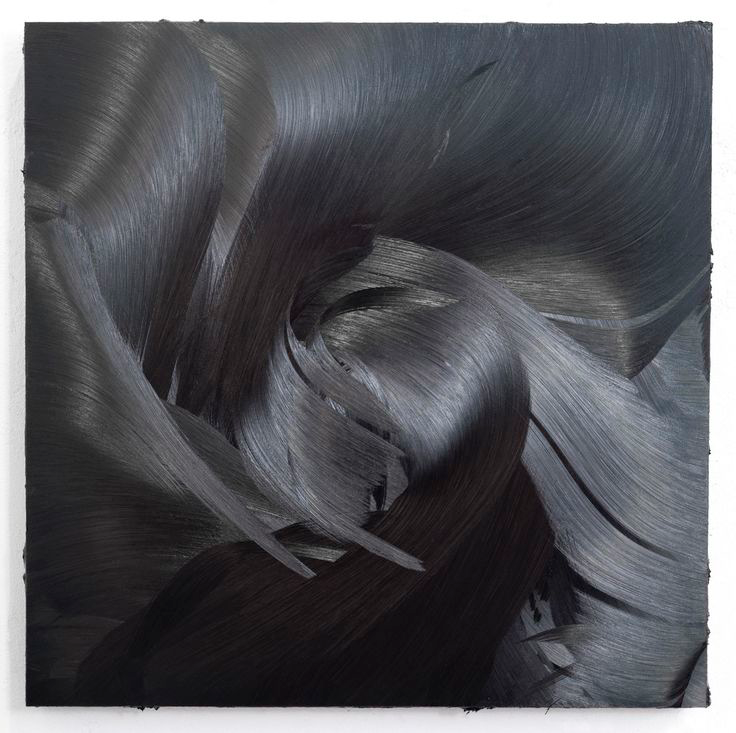
Remember of a later piece of work by Van Gogh. A field of hay doesn't for nearly people expect the mode he painted it. His own fashion, his signature marks accept over. Then has Van Gogh lied in making this painting. Well, I believe he purposely misrepresented facts and and then I believe he did prevarication.
At start glance the earth seems to look less like a painting by Van Gogh and more similar a piece of work by Pedro Campos, a photo-realistic artist who has painted soda cans and then realistically the work looks like a photograph. However, the fact his work is tighter, more specifically depictive may not absolve him from accusations of using paint, i.e. lying to obtain reality. In fact, I'd fence this is exactly what makes his piece of work compelling to many as opposed to merely a photograph.
Artist Alyssa Monk, some other photo-realistic artist, says speaks works in the bathing series explore the tension between reality and invention. She says she has to make h2o out of paint, and that part of the claiming is to effigy out what to use from a photograph and what to invent. Note her words carefully. Clearly for her it'south not just a re-create just it includes invention, lies.
Many artists say they paint what they encounter as though this solves all the problems. This is correspondence with reality is seen as an entirely sufficient answer. Simply I wish to interrogate this line of thinking too, and to suggest that to paint the earth as we see information technology becomes problematic very apace.
Ane out of ten men, and one out of 100,000 women who do non take normal color vision. We are aware of deteriorating vision, as with cataracts, which might crusade the globe to appear yellowed.
There are further problems. We know the retinal cones, simply the color sensing cells of our eye, fatigue as we look at things over a menstruation of fourth dimension. Every bit a result, colour modify the longer we expect. nosotros come across flickers of other colors, halos of colour around bright objects. In fact 2 artists specifically focused on painting the fleeting auras that occur when colors are adjacent, namely Georges Seurat and Paul Signac. Await closely at the edges where colors encounter and you lot'll see how the colour are modulated. They get lighter side by side to nighttime colors, darker next to light colors, redder adjacent to greens, and greener next to reds.
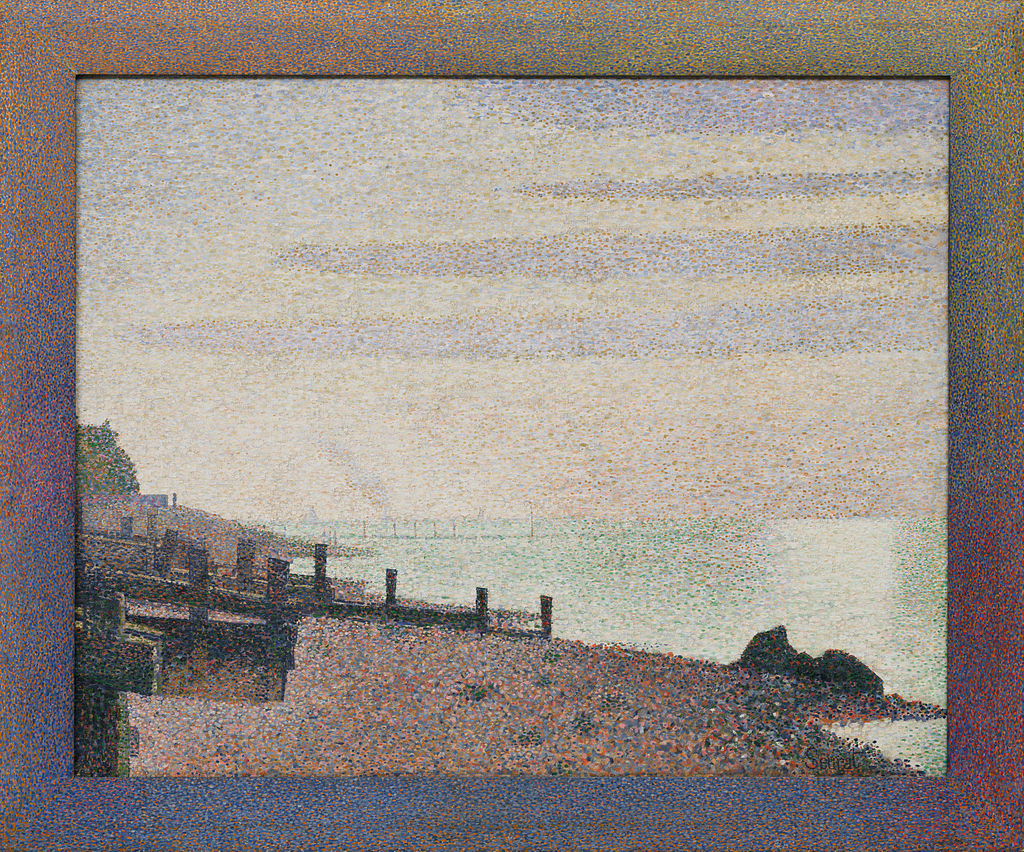
Josef Albers set up conditions in his Homage series of paintings to force colors to interact in a way that caused some colors to perceptually radiate, flicker, or fifty-fifty disappear.
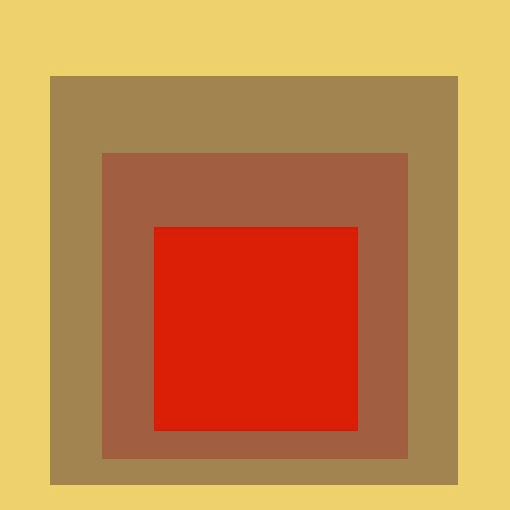
What each artist recognized is that colors become unstable upon prolonged viewing.
The globe of color then, every bit something stable is disproven. Our perceptions of the world are changeable and unreliable. The truth of the world in a universal sense, cannot be, then, equally we individually run across information technology. Artists oft say, "I pigment the earth accurately, as I encounter it" and I have all these questions, How practise your eyes piece of work, For how long did you stare at the colors? How did y'all decide upon one of the many variations in that child-bearing colour you stared at?
Once we recognize this, nosotros see instances in which nosotros oft cannot even agree upon what we encounter.
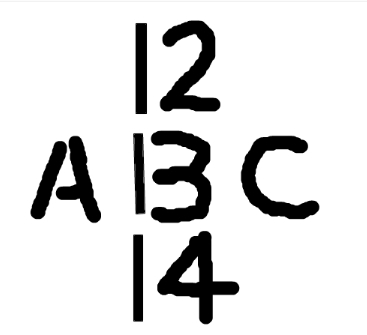
Things tin can get worse equally with the Rotating Snakes of Akiyoshi Kitaoka in which nosotros run across center-bending encephalon busting move in a not moving configuration.
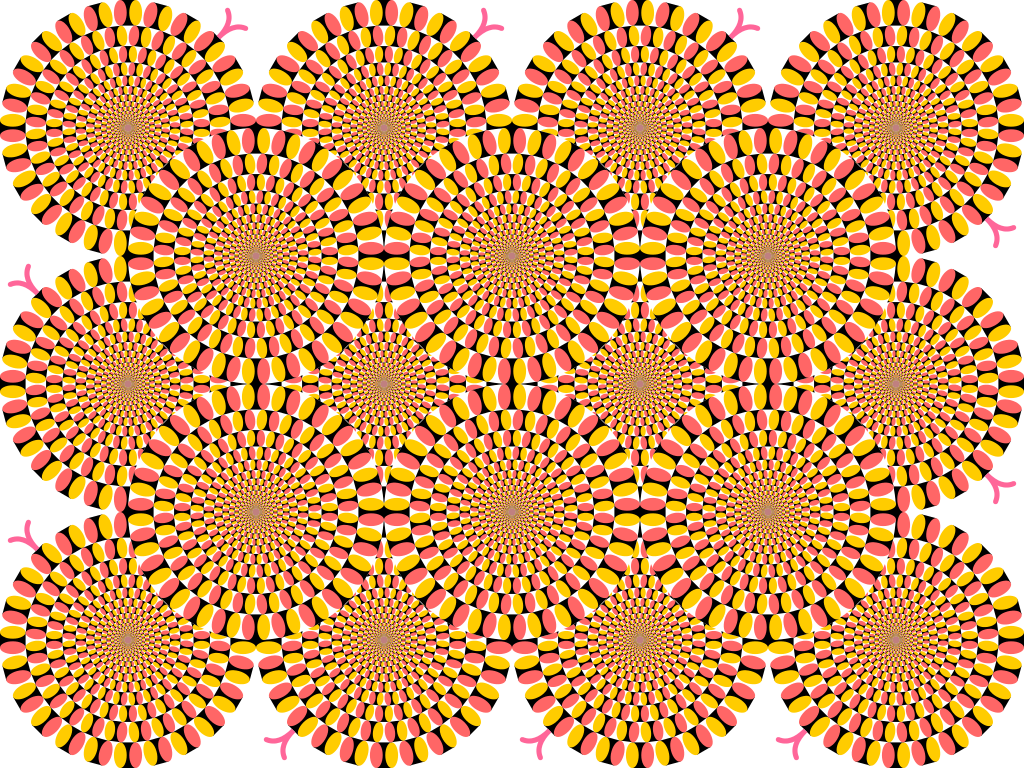
OK, before we caput into some new ideas, let'due south epitomize where we are currently at.
We may accept some degree of truth in marks or some degree in a compilation of marks. Simply certainly we tin can also reframe this give-and-take every bit ane of lies. The marks are all picayune sorts of lies that add up to one big lie.
I remember standing before a Monet painting at the Metropolitan Museum of Art in New York Metropolis. Upward close it looked like a cat had vomited. Simply as I moved dorsum, the various dips and daubs of color began to coalesce and the configuration of painted marks turned into an image of the Cathedral at Rouen. It wasn't a cathedral, nor was it a photograph of a cathedral, just it was definitely something near that cathedral in a very specific lighting condition. To describe this fact, I volition apply the last words of Raymond Carver in his brilliant brusk story titled Cathedral, "It's really something." Magic always is.
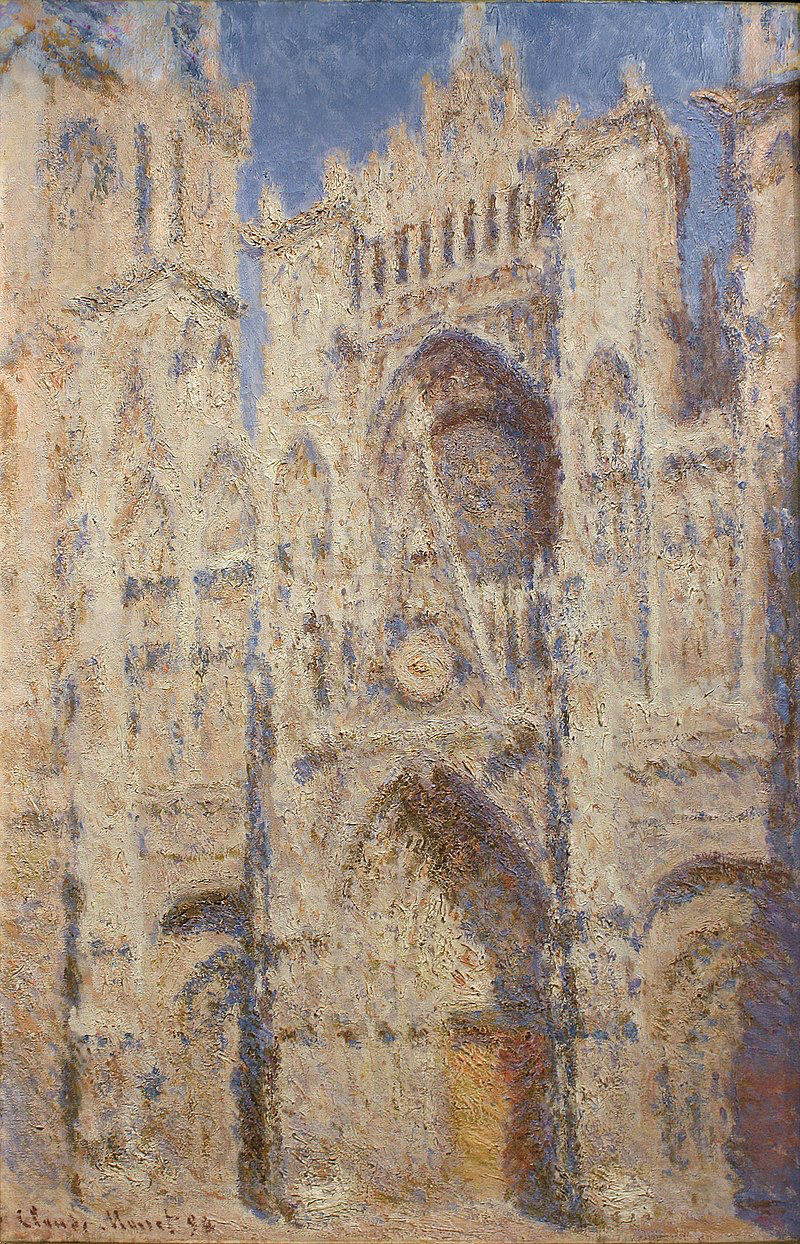
Now what I enjoy doing, in a Ideal manner, is to establish a sort of background and so brainstorm to test it. This is where I grin to brand help the medicine go down.
Maybe art does non capture the truth, by which I mean some form of ongoing, lasting, unchanging truth. That seemed clear with respect to the changeability of human perception. Maybe our respond is this: Art is just a momentary glance. And in this nanosecond of capture, we get some sort of momentary reality. I retrieve Dutch notwithstanding life paintings are much like this because we are enlightened that the food will rot, the dog, the monkey and the parrot will leave, and so forth.
Creative person Marking Tansey has played with this notion, suggesting that artists are able to permanently solidify the moment although he pushes the idea to absurdity. In Action Painting 2 a painting class stands with easels and brushes painting the infinite shuttle equally it lifts off.
But perhaps at that place is another route. Even if we pigment the world as we see it, we may take that others run across information technology somewhat differently. However, we may suggest that there is still something important that is shared in the art. Because Monet's cathedral we get a feeling of the twenty-four hours, of the light he captured from his apartment window as he looked across the square to the building. I accept pointed out what I think is the Platonic view versus the Aristotelian view of the world. On one hand Plato said an artist was "an imitator of images and is very far removed from the truth" (Democracy X, 27). On the other manus Aristotle said, "The aim of fine art is not to represent the outward appearance of things, merely their inward significance." (Attributed to Aristotle past Seneca in On Tranquility of Mind).
I retrieve that often art does function metaphorically, and nosotros realize some truth through it. George Orwell'southward Creature Farm is a obvious example. The truth is in a way the story of the animals, only nosotros besides know the truth is the individuals the animals represent, Stalin and Trotsky and we know the farm is meant to be the Kremlin.
Even non-artists probably know the famous work past René Magritte. He depicted a pipe and yet he added words saying this is not a pipe. He wrote: "The famous pipe. How people reproached me for it! And yet, could you lot stuff my pipe? No, information technology's merely a representation, is it not? So if I had written on my picture 'This is a pipage', I'd have been lying!" Magritte recognized that the prototype was a prevarication because the image was a painting, a picture, and not a existent pipe. In this sense he was grappling with the notion that art was frequently hands talked almost as though what it depicted were a thing of the globe, which it was not.
But as Magritte noted, people easily suggest the faux is the existent all the time, with diverse levels of belief and colloquial linguistic communication. And so the discourse is further opened.
Irish Poet, Paul Muldoon in a contempo Paris Review magazine wrote, "Oh, I recollect one of the great things about being a writer is the extent to which it allows u.s.a. to invent ourselves. Information technology'south similar being in a witness-protection program. A very, very beloved friend, a adult female I went out with briefly, years ago, said to me once, How's May? I said, Who's May? She said, May'south your sister, isn't she? So then I got it. At that place's a verse form called "Cuba" in which there's mention of a sis called May, who doesn't be. And still the poem, in many ways, is historically accurate and in some ways happened. Just not quite in the style that'southward suggested. There are dangers, of course, with inventing people, including oneself." ( Paris Review)
Now lets all climb into some tricky and contemporary territory with a nod to Pere Borrell del Caso and his painting titled 2 Laughing Girls in which a hand appears to extend beyond the virtual world and into our world.
We can imagine that art'south correspondence with the real world is sort of realism that allows u.s.a. to consider the possible confusion.
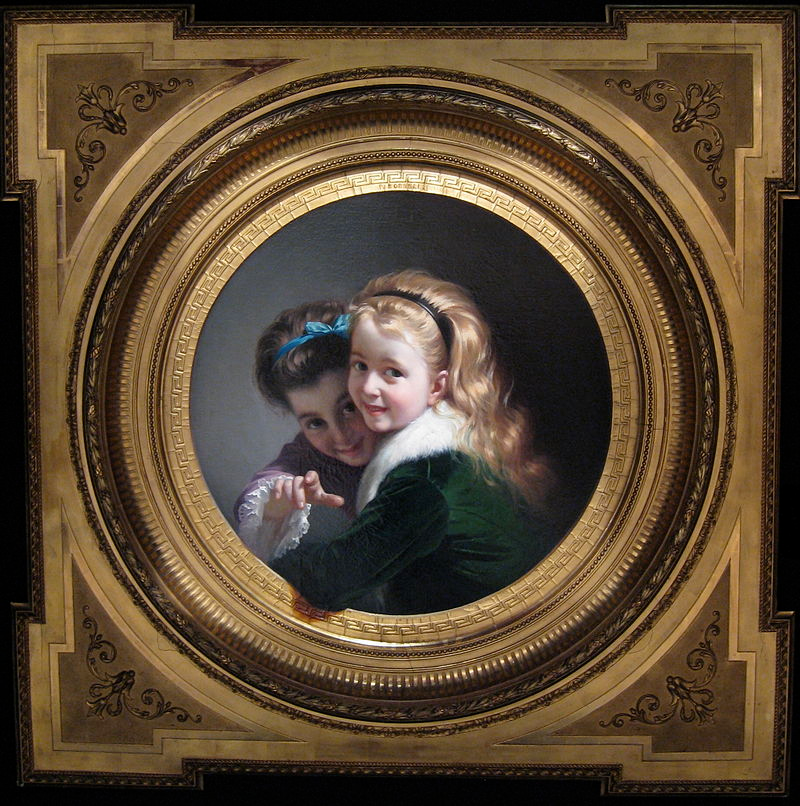
In his fable called On Exactitude in Science, Jorge Luis Borges wrote about a magical kingdom in which cartographers created a map so large and detailed that it lay perfectly over the existing land. This idea lead Baudrillard to think about the relationship of reality to models of reality.
To remind the states, for example.
Imagine a painting, Mona Lisa. At present imagine that somehow the original was destroyed and that people then forgot about the original. And instead, all that existed of the Mona Lisa were many digital files, without any single original digital file, and that these files were used all over the identify to create diverse forms of art. Baudrillard wondered, what would the world exist in such a state of affairs, what would fine art be in such a situation?
Not only are we recognizing the illusory and problematic nature of art, we will now detect artists who not simply mentioned the issues as did Magritte, but who actively made the problems the subject of their art.
Creative person Robert Gober created a canvass of plywood, an individual, hand-crafted layered and laminated piece. The manus-crafted artifact is presented equally the industrially made object. The lie and the truth are slippery.
Playwright, Harold Pinter from his Nobel lecture in Art, Truth & Politics, 2005 wrote "In that location are no difficult distinctions betwixt what is real and what is unreal, nor between what is truthful and what is false. A thing is not necessarily either truthful or false; it tin can exist both truthful and simulated." Truth is elusive, it may exist glimpsed and the search for information technology is e'er the chore of the artist.
On Jan 16, 2019, The artists The Yes Men created a false Washington Post newspaper with the headline, "UNPRESIDENTED: Ending Crisis, Trump Hastily Departs White House," that they handed out to D.C. commuters. Lies and conscious deception. And all the same our thinking is directed to the truth, the truth establish in or revealed past fine art.
Art is a prevarication that makes usa realize the truth. In the face of art censorship is a hollow gesture.
In 1998, creative person Liza Lou finished her installation of Lawn. Quite a beautiful backyard. Quite a bit of reality. When I say finished, I mean she completed a piece of work made of 30 million glass beads. 250,000 beads are used in the grass alone.
Tom Friedman worked, co-ordinate to the artist, on an art work between the years of 1992 and 1997. What did he exercise? He spent k hours staring at a slice of paper. The work now resides in the permanent drove of the Museum of Modern Art in New York City.
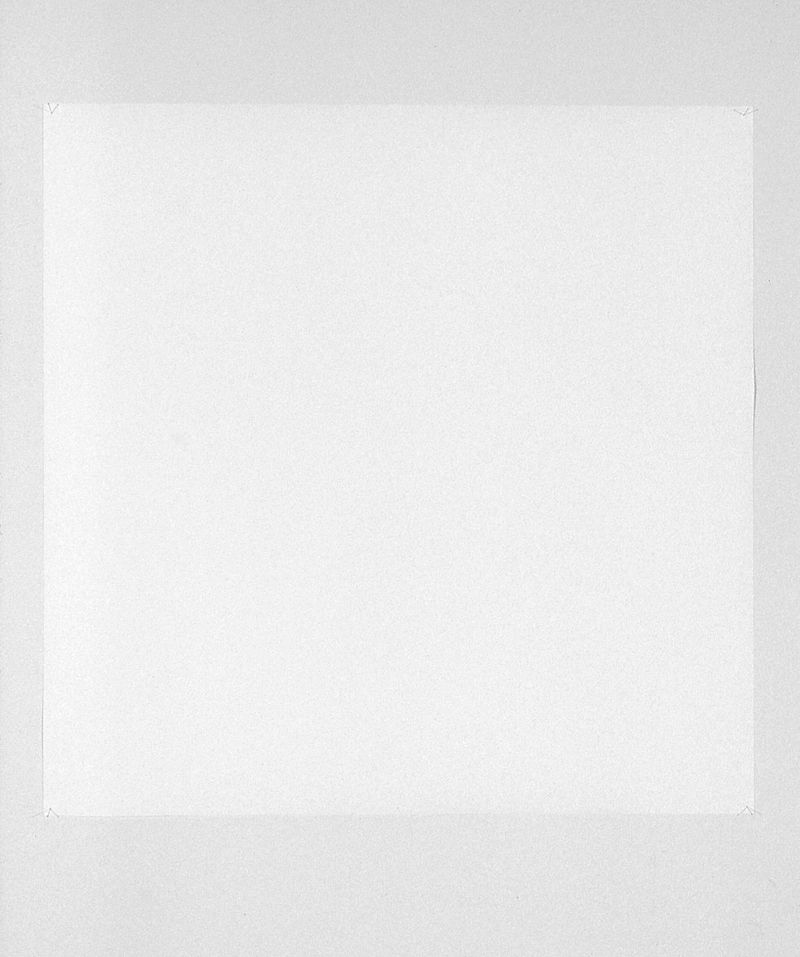
Artist Joseph Beuys claimed to have survived a World State of war II airplane crash that was the impetus for many of his works. He said his aeroplane was shot down on the Crimean forepart and he was rescued by the Tartars who wrapped him in felt and rubbed him with animal fat and fed him milk and honey. The events and the crash were accepted equally fact for many years, just then the accuracy of events surrounding the crash and his eventual rescue began to be doubted, (e.g. Buchloh, Krauss, & Michelson, 1980; Knöfel, 2013). The creative person died in 1986 having never cleared upwardly the debate. Today there is a skilful deal of skepticism equally to whether whatsoever of his business relationship actually occurred, however equally Borer (1996) wrote,
"The legend of Beuys must be held for the truth, not considering the facts at its source may be true (they accept never been completely substantiated) but because a fable is neither 'true' nor 'untrue' […] but Joseph Beuys' legend must here exist taken for the effect of truth, indispensable to any assay of his work, and every bit such should be sung: in this way it is truthful." (p. 12–thirteen)
One way to consider this is that although the facts provided by the artist were without reliable justification, at times one was required to suspend justification in order to read the work in the manner that the artist intended, in this instance within the realm of myth. So much for justified truthful conventionalities as the defintion of noesis.
The artist is a liar, the fabricator of stories. The artist's lies cannot be separated from the truth. The artist cannot be trustworthy on this account, they are unreliable narrators. We volition never know whether Friedman told the truth or not.
There is a famous painting by Rubens titled Helen Fourment in a Fur Coat which is if anything a foreign and interesting painting. Fourment was the wife of Rubens. She married him when she was xvi years quondam and he was 53. Poet January Caspar Gevaerts said her beauty surpassed Helen of Troy. Well beauty is in they center of the beholder. This portrait has been analyzed by those who understand anatomy and the conclusion is that her body in a higher place the hips faces away from us, while her legs face toward us. The merely mode this could occur would be through a broken back. Clearly, Rubens has presented a lie.
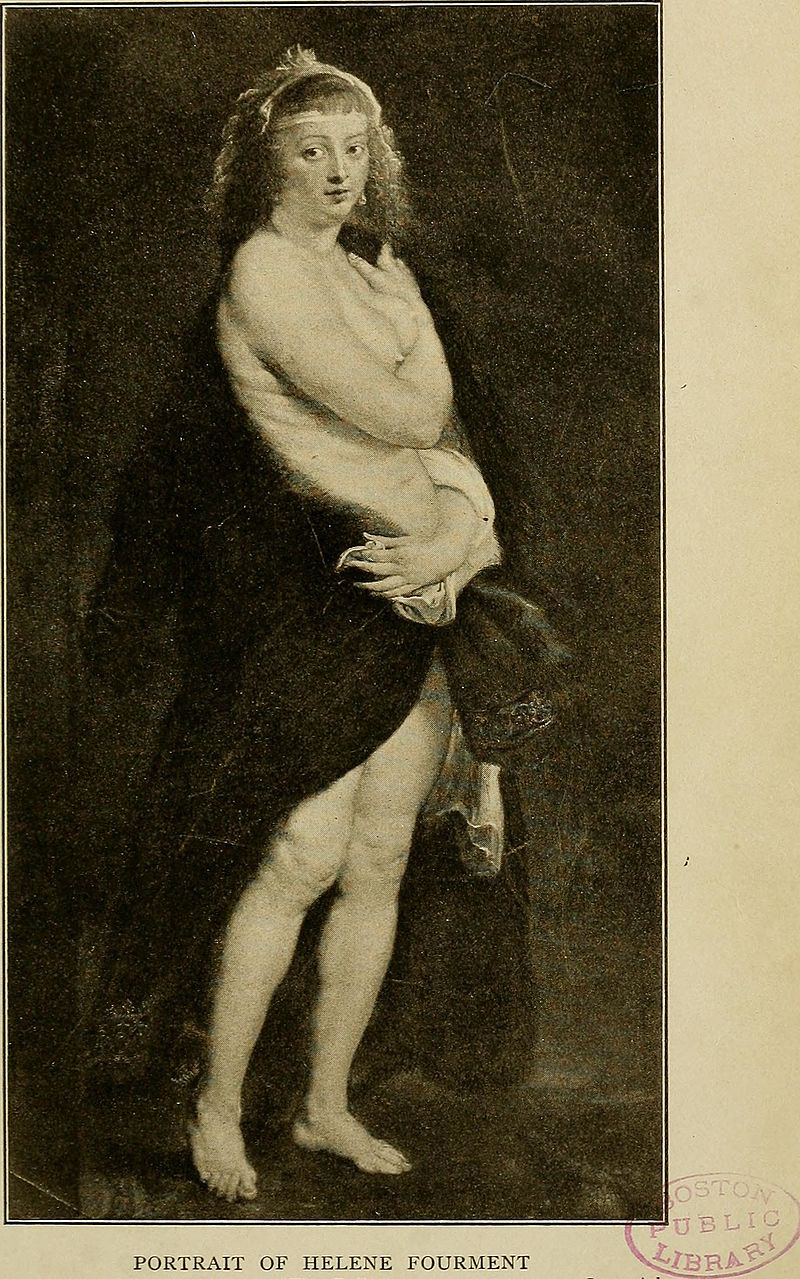
Giangiorgio Trissino (1478–1550) in his treatise on poetics published posthumously 1562. tells this story. The priest Arlotto was in Florence on a road and as a very beautiful young woman passed past him he said to his traveling companion, "This is a beautiful woman"; and the young adult female turned and said: "I cannot say the same of you lot." Arlotto immediately answered, "Yes, indeed (y'all could), if you wanted to lie most me as I lied about you."
Hither are a couple examples of lying in fine art that are fairly fascinating. The first is attractive and the 2d and second somewhat shocking. I urge you to trust me and not get too upset before you read the entire story.
Here'southward an example of fine art that philosopher Edmund Burke in his 1757 treatise might phone call sublime. What a landscape. Here we see mountains, and clouds, and copse following a fast moving storm. This is a work past artist Kim Keever.
And here is how it was done. He built the entire scene from plaster and imitation trees, with paint and he submerged the unabridged miniature mural in an aquarium. He directed spotlights with colored gels upon the scene. So he injected in a milky substance that in the h2o looked like clouds. It's amazing tom foolery.
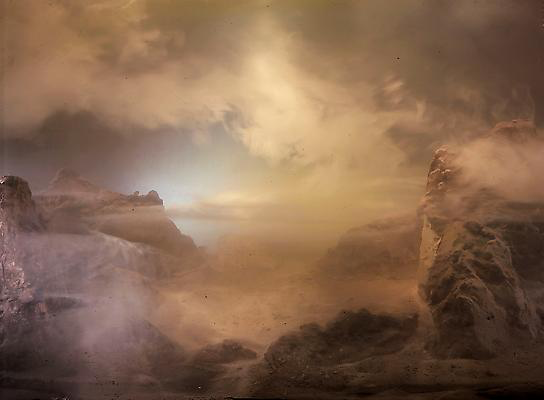
"Yous're telling a prevarication in order to tell the truth." Those aren't my words. They are the words of Wolf Koenig, Canadian moving picture director, producer and animator, who died in 2014. He said about his film, "Every cut is a prevarication. It'south (which I think he means life or the scene) is never that fashion. Those two shots were never side by side to each other in fourth dimension that way."
On to the 2nd example.
Guillermo Vargas, a Costa Rican artist had an exhibition in which along with some other controversial works, he exhibited a dog tied to a wall. On the wall written in canis familiaris nutrient was Eres Lo Que Lees, or in English, you are what you read. Photographs like this one appeared all over the internet. It was said that people showed upward for the opening, and ate and drank, and that ultimately the domestic dog starved to bespeak out the greed of people in the face of poverty. Here is what the artist said:
"How-do-you-do everyone. My name is Guillermo Habacuc Vargas. I am l years sometime and an creative person. Recently, I take been critisized for my piece of work titled "Eres lo que lees", which features a dog named Nativity. The purpose of the work was non to crusade any type of infliction on the poor, innocent brute, but rather to illustrate a point. In my home urban center of San Jose, Costa Rica, tens of thousands of stray dogs starve and dice of illness each year in the streets and no one pays them a 2nd thought.
At present, if yous publicly brandish one of these starving creatures, such as the case with Nativity, information technology creates a backlash that brings out a big of hypocrisy in all of u.s.a.. Nascency was a very sick creature and would have died in the streets anyway"
I know, this is all worrisome, just just hang on a fleck longer.
Once find of the prove hit the cyberspace petitions appeared everywhere. They called for banning the artist from whatsoever future shows. There were petitions. More than than a million people sighed one of the petitions urging the organizers of a large biennale Vargas was to appear in to stop him from showing in it.
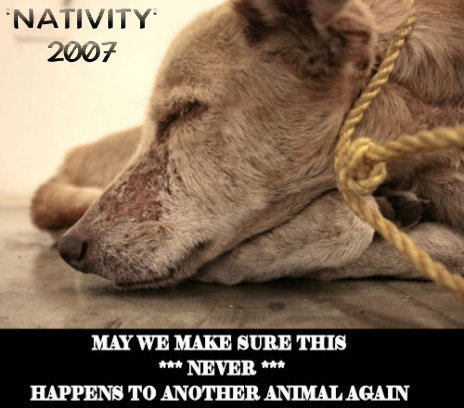
Now let's look at reality. Vargas was not 50 years old, he was 32 at the time. Secondly, according to The Guardian, the canis familiaris was tied up for the three hours of the exhibition and fed regularly with dog food that the artist himself brought in. The dog was not starved. It was a prevarication.
The problem rests on our assumption that the artist is truthful, reliable, and in fact many contemporary artists are not, or we might even suggest that no artist is. Fifty-fifty a realistic, highly depictive painting is nothing merely spots of colored mud on a flat surface.
Considering nosotros presume the artist is reliable and we get upset when the creative person seems to breach normative ethics.
This is the power of art. It somehow, through its artifice, taps into something human, something deep and meaningful, existent and undeniable.
Here are a couple more than examples.
Kijong-dong, Peace Village, is a town on the border of South and North korea. One can encounter houses, a school, a flag pole, the water tower, a hospital. Information technology is claimed 200 residents live there. And yet, the village has been claimed to be completely imitation.
According to Grigory Potemkin, a facade of a village was constructed for Russian Empress Catherine the second'south journey to Crimea in 1787. The reason it was constructed is debated, maybe to prove that economic prosperity thrived where it did not, perhaps to reassure as she went to slumber at night almost the possibility of people in an uninhabited area. Kijong-dong is a Potemkin hamlet co-ordinate to people who accept scrutinized the buildings. Buildings appear empty, sometimes the sidewalks are swept to give the illusion of domicile, lights are on timers.

We do the same thing in movie making, for example in a western town on the dorsum lot of a picture show studio.
Let u.s.a. remember for a second that Beuys said his plain was shot down on the Crimean front. Did he know the history of the Potemkin village?
Here's a question for the states….Is this fake town of Kijong-dong art?
The protagonist of Cather in the Rye, Holden Caufield said, "I'grand the nigh terrific liar you ever saw in your life. It'south awful. If I'g on my way to the store to buy a mag, even, and somebody asks me where I'm going, I'm liable to say I'k going to the opera. Information technology's terrible."
Withal, Holden likewise despises people who he says are phony, or insincere. Nonetheless in reading the novel, we realize he is the fictional story teller, and as he admits a liar. He is a phony likewise.
The dandy Peruvian writer Mario Vargas Llosa said in Making Waves, "Literature extends homo life, calculation the dimension that fuels the life deep within us — that impalpable and fleeting but precious life that nosotros only live through lies.''
Llosa in his volume Aunt Julia and the Scriptwriter tells a complex story of Mario, an 18 yr erstwhile pupil who falls in love for his 32 year old divorced aunt. He wants to be a writer and he gets a job at a radio station where each day the station runs soap operas imported from Cuba that are frequently of a terrible, depression quality. Then they hire an eccentric man, Pedro Camacho, to write the soap operas. Nevertheless Pedro is overworked, he writes 10 half 60 minutes serials a mean solar day, and because he is eccentric, he is unable to separate fiction. Soon his afternoon serials begin be about his own problems: his hatred of Argentina, his constipation, and about anything that enters his surrealistic imagination. Those who mind to the show are both intrigued and confused. So at present we have the writer Camache, confusing reality and fiction, although the "reality" is really a fiction created by the writer Llosa which was based on the reality of his ain life.
Visual creative person Cady Noland, American artist, who apparently doesn't create art anymore is in office known for a wonderful installation with the name This piece has no title nevertheless from 1989, at the finale of the rah rah era of Reaganomics. It is a construction of beer cans, scaffolding, and flags. It references bunker walls, a cannon. We discover the way in which American patriotism is mixed with six packs, American drinking, a construction site, good Old Glory red, white, and blue that at times looks completely armed services, ruby-red white and blueish. Plain beer drinking, a limp flag, and militarism build a strong America. Noland'southward work has been called excellent at presenting the taboo underbelly of the American dream, her work has been called contemporary and timeless, she has been cited as an installation wizard.
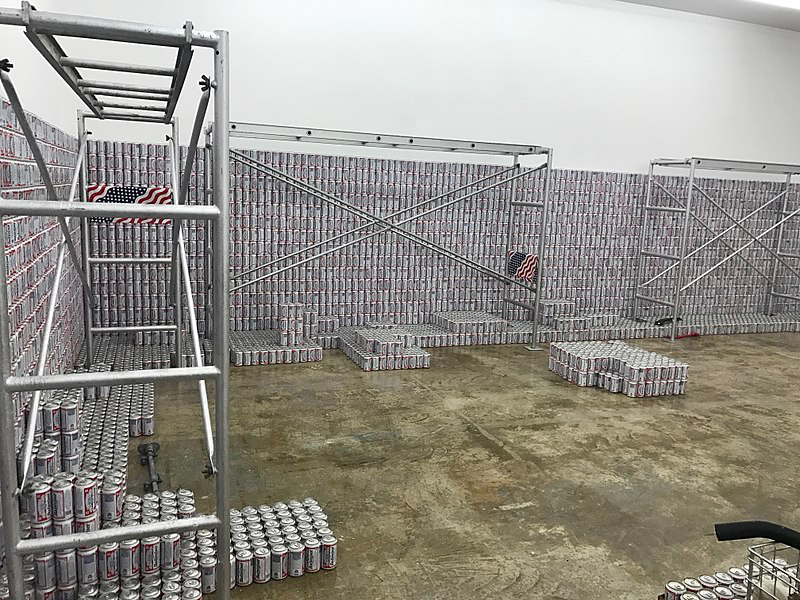
Oscar Wilde said, wrote, I'd like to go it right so I'one thousand not defendant of lying, "Lying, the telling of cute untrue things, is the proper aim of Art."
We have seen many variations of lying. But do we concur with Wilde. Is lying the proper aim of art? I suggest that artists cannot do much else only prevarication. The slide mud around on a surface, they react to a changing vision, they put the world some sort of subjective, often arbitrary manner. Then they nowadays their lies to the world and everyone speaks of truth and reality. Isn't it all 1 big lie? Even with the camera the world is framed, distorted, reduced, shifted in color, and and so forth. There is nothing here closer to the truth either.
So nosotros can encounter, artists tend to be liars on nearly every level. They can't assistance information technology. They are forced to.
Can an artist escape lying? What might art await like if it were, or could be just truth, as they say in courts in the United States, the truth, the whole truth and nothing but the truth? We are now post-mail service modernistic, plural. Annihilation and everything tin be art. To add a dose of sobriety to the discussion, it was in 1990 that Jean Baudrillard wrote in The Transparency of Evil: Essays on Farthermost Phenomena that art had a "fundamental interruption in the secret code of aesthetics….No matter how marginal, or bland, or even obscene it may be, everything is subject field to aestheticization, culturalization, museumification." In otherwords anything and everything is or can be fine art. In other words, there an exist no differentiation between the truth and the lie, or the prevarication and the truth.
I suggest 1 artist as a possible example, this is Tehching Hsieh. He did two projects that seem adequately truthful. The showtime was a one year performance in which from April eleven until the following April xi, he punched a time clock on the 60 minutes every hour. He shaved his caput at the start and then every time he punched the time clock, he took a motion-picture show of himself.
The second was another one year operation. In this work, Hsieh locked himself in an 11.5 ten 9 x eight foot wooden muzzle. He had a washbasin, lights, a pail, and a unmarried bed. He did not talk, read, watch telly, or listen to the radio. A friend came one time a day to deliver food and remove the creative person'south waste matter and to have a single photograph. The work was open to public viewing twice during the flow of his solitude.
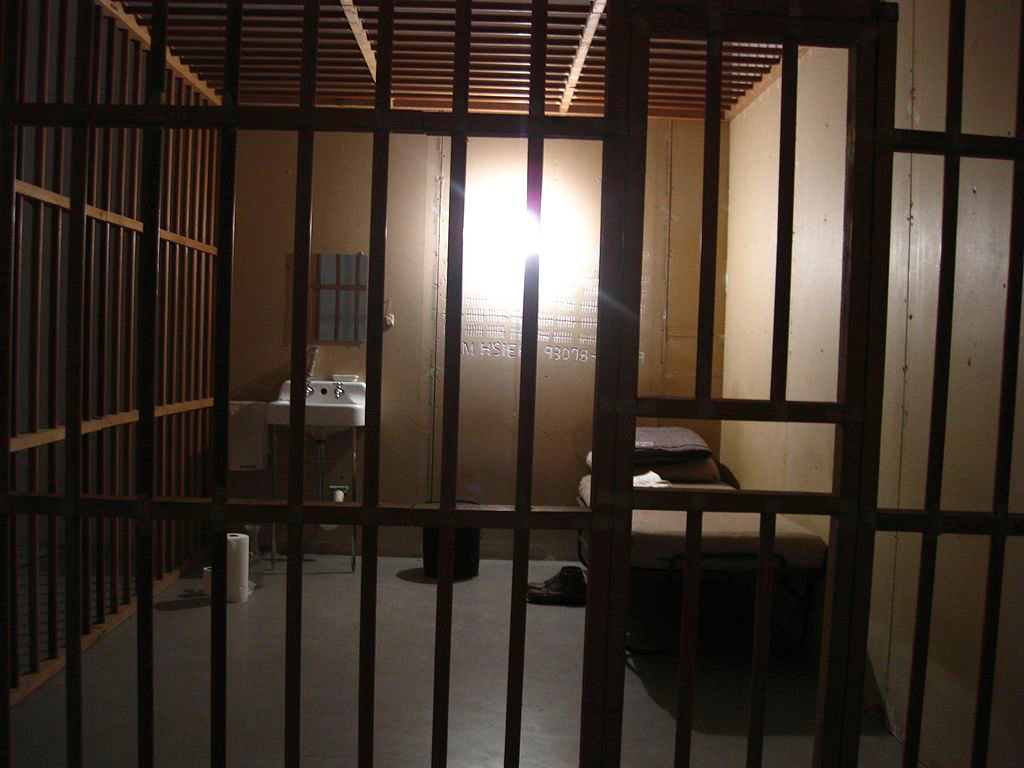
I don't quite encounter these works of fine art equally faking, or lying about anything. But, we do get to suggest that for a specific amount of time he has delimited his reality, he has called specific parameters to create art within, and in a way this has a lot to do with reality just as it has little to do with reality.
Artist David Kemp made a kick domestic dog.
Creative person Jeff Koons made a balloon dog.
Visitor Oscar Mayer made a hot dog.
Is any of this stuff real or truthful?
George Santayana wrote, "Truth is only believed when someone has invented information technology well."
In his Satire on False Perspective of 1754, Hogarth using demonstrated the machinations of the illustrative lie and in doing so showed that viewers have to be convinced of the prevarication offset, to begin to realize the truth.
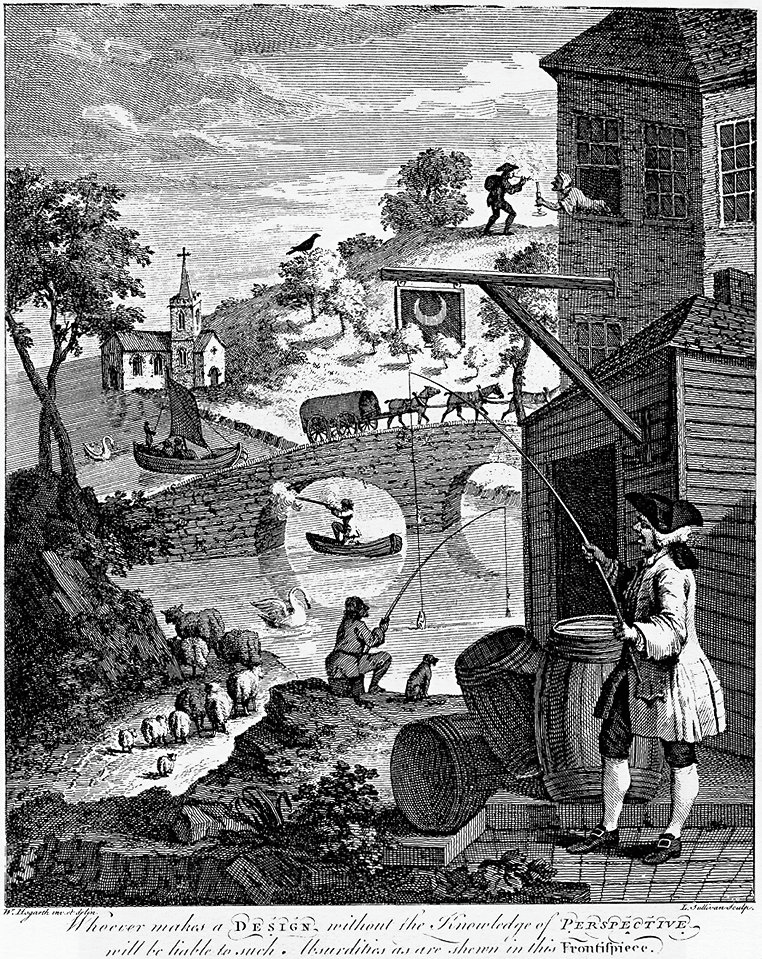
Nosotros are now in the position to empathize another painting by Marking Tansey. In it a woman has painted a notwithstanding life. The painting washed, she is throwing out the real flowers. The existent is trashed, the fake is kept. The lie of the painting is now said to exist the real of the flowers. It is a all the same life. It is besides, life, still, non-moving and information technology is still, as in standing, life, found in the depiction of the lie, the painting.
I think in asking what the human relationship betwixt fine art lies and truth is, we are really asking: What is the power of art that allows it to be, to move people to laughter or tears, to exist sublime, to be evident? It is merely this. Art contains truth. Art contains lies.
Art contains reality. Fine art contains myth. Every bit Paul Muldoon said, the master role of art is to "brilliantly delight us again and again." In making art nosotros discover something near ourselves in the world. In sharing art we show the world something virtually ourselves. Artists may be liars, true enough, but would we accept it whatsoever other style? I promise not.
Source: https://christopherwillardauthor.medium.com/art-the-lie-that-tells-the-truth-8d14c58199fd
0 Response to "Art Is the Lie That Makes Us Realize the Truth"
Post a Comment